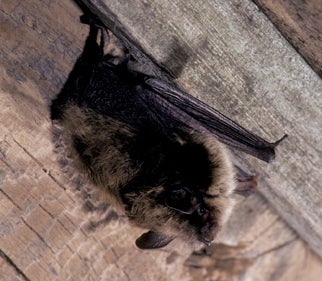SCIENTIFIC NAME:
Myotis lucifugus (LeConte)
OTHER NAMES:
Little Brown Bat (Fenton and Barclay 1980, Harvey et al. 1999).
STATUS:
Likely found statewide. Once common throughout its distribution, it is becoming increasingly rare in the eastern U.S. due to the fungal affliction White-nose Syndrome which is devestating some local populations. Rare in Alabama with no breeding colonies known. HIGHEST CONSERVATION CONCERN.
DESCRIPTION:
A medium-sized myotis (total length, 8-10 cm [3.2-3.5 in.]; weight, 5.5-9.5 g [0.2-0.3 oz.] with a dark-brown dorsum and sleek and glossy pelage, often with a metallic sheen. Venter is paler, sometimes slightly grayish, and ears and wing membranes are brownish. Similar in color and size to the Indiana myotis, but does not have a keeled calcar. In addition, presence of hairs on the feet that extend beyond the toes of little brown myotis is a useful characteristic in distinguishing between these species (Barbour and Davis 1969, Fenton and Barclay 1980, Choate et al. 1994). Subspecies of eastern North America is M. l. lucifugus (Fenton and Barclay 1980, Hall 1981a).
DISTRIBUTION:
The broadest distribution of any North American myotis; except for the southern Great Plains, extreme Southwest, and parts of the Southeast, it occurs from northern Alaska into the southern United States and from coast to coast (Fenton and Barclay 1980, Hall 1981a). Common in the northern part of its distribution, but uncommon throughout the southern portion, including Alabama (Choate et al. 1994).
HABITAT:
Colonies may be in tree cavities, underneath rocks, in piles of wood, in crevices, occasionally in caves, and in a variety of human-made structures. Will roost in any sites with appropriate microclimates, and they quickly locate and exploit new roosts (Barbour and Davis 1969, Fenton and Barclay 1980, Choate et al. 1994).
FEEDING HABITS:
A variety of insects are consumed, including flies, moths, and small beetles.
LIFE HISTORY AND ECOLOGY:
Maternity colonies of up to several thousand females begin forming in spring, frequently in warm buildings including attics of occupied houses. They may use the same maternity sites year after year. Males and nonreproductive females roost singly or in small groups in warm months. Roost sites are near water. Dispersal from winter hibernacula ranges from short distances to 500 kilometers (300 miles). Forage at dusk, frequenting the same areas night after night. Usual flight path is over water (lakes, ponds, streams, and rivers) and along edges of woodlands. Small insects are eaten in flight, but will land to consume larger prey. Lactating bats tend to select larger insects than males or nonreproductive females, but chironomids are still the staple food. Tend to take insects three to 10 millimeters (0.1-0.4 inch) in length. Their rapid rate of mastication (seven jaw cycles per second), short time for passage of food through the digestive tract (35-54 minutes), and rapid feeding in clumps of insects, appear to be specializations for minimizing between-capture intervals and maximizing rate of turnover of food. Ability to exploit a wide range of roosts and foods probably contributes to large populations of this species in many parts of distribution. Hibernation occurs October-April. Caves and mines with relatively high humidity and cold temperatures are typical hibernacula. Hibernate singly or in small clusters, hanging from the wall or ceiling, or wedging themselves into cracks and crevices. Hibernacula often are shared with other species of bats. Mating occurs directly before hibernation, but copulating pairs may be found in the hibernaculum throughout winter. Fertilization occurs after ovulation in spring when females arouse from hibernation. Timing of these events is influenced by local conditions, resulting in earlier dates for parturition in more southerly parts of distribution. Gestation is 50-60 days. One young (rarely twins) is born in spring. During parturition, females reverse their usual head-down posture so that neonate is born into the interfemoral membrane. Young use deciduous incisors, along with large thumbs and hind feet, to cling to mother. Growth is rapid; they can fly at three weeks old. Maximum lifespan of several individuals in the wild was more than 30 years. Average lifespan probably is 10-15 years (Barbour and Davis 1969, Fenton and Barclay 1980, Choate et al. 1994, Harvey et al. 1999).
BASIS FOR STATUS CLASSIFICATION:
Rare in Alabama. Based on broad distribution in Alabama and size of populations where it occurs elsewhere, potentially should be common in the state. Extensive netting and cave surveys throughout Alabama in the past 15 years have yielded no observations.
Author:
Troy L. Best







